Introduction
Florida, with its beautiful year-round temperate weather, is not only pleasant for horse owners, but also a perfect environment for various toxic plants to thrive. Whether at home focusing on pasture management or out on the trails, horse owners should be aware of the toxic plants that pose a potential danger to their horses’ health. This publication is intended to provide horse owners with critical information about common toxic plants encountered in Florida.
Pasture Management and Weed Mitigation
Any undesired plant, whether a broadleaf or a tree, is considered a weed. In general, horses are discriminate eaters and will avoid eating weeds if ample grass pasture or hay is available. However, when pastures are overgrazed or improperly managed, they are more susceptible to weed invasion, and horses are more likely to browse on weeds when there is nothing else to eat. While not all weeds are toxic to horses, some can cause illness or even death if sufficient quantities are consumed. The best way to prevent horses from eating toxic plants is to regularly inspect pastures and fence lines and remove unwanted plants. If a toxic plant is discovered, it should be killed via chemical application or physically removed, or the area should be fenced off to prevent horses from grazing in the affected region. Frequent inspection is important, because seeds may be carried into pastures by wind, birds, and other wildlife, leading to new growth of toxic plants.
Ornamental plants used for barriers and landscaping may also be toxic to horses and other livestock. Owners should be aware of ornamental plants around the property and along pasture perimeters and avoid planting any toxic species whenever possible.
Good pasture management is essential for promoting the growth of healthy grasses and avoiding the proliferation of weeds. Pasture management practices include:
- Soil testing
- Liming and fertilizing
- Grazing management
- Mowing
- Chemical weed control as needed
While mowing is an important part of pasture management, it may be ineffective for permanently removing unwanted weeds. Therefore, physical removal or herbicide application is the preferred method for management of toxic or other undesirable plants. When treating pastures with herbicides, adhere to manufacturer recommendations regarding waiting periods before allowing animals to graze the land. Even though most pasture-labeled herbicides do not have grazing restrictions (horses are considered to be livestock on herbicide labels), application of herbicides can make toxic plants more palatable. For this reason, it may be best to remove horses until toxic plants have completely desiccated.
Suspected Poisoning
If you suspect that your horse has ingested a toxic plant, contact your veterinarian immediately. If possible, collect some of the toxic plant for identification. Take a photo of the entire plant, bush, or tree, and collect leaves, seeds, stems, and flowers. Your veterinarian will be able to provide the most accurate prognosis for your horse and may be able to administer medications that reduce the absorption of toxins into the bloodstream.
Common Plants Toxic to Horses in Florida
*Plants are listed alphabetically.
Azaleas, Rhododendron ssp.
Description
Azaleas are commonly used in landscapes because they are shade tolerant and offer an array of colorful blooms. There are numerous azalea species, some native to Florida, which thrive in the climate throughout the entire state. Azaleas are typically kept as large shrubs or trees. Leaf size and shape vary greatly across different cultivars and subspecies of azalea. Leaves typically measure from ¼ inch long to more than 6 inches; deciduous cultivars tend to have larger leaves than evergreen cultivars. Most leaves have a football shape, but some are thin and narrow. Plant height can range from 1 foot to 15 feet tall. Typical flower colors include yellow, orange, pink, red, white, and purple.
Toxicity
All parts of the azalea plant, even their nectar, contain grayanotoxins. Grayanotoxins act in a number of ways and affect multiple internal systems of the horse, most notably the cardiovascular, gastrointestinal, and respiratory systems. Grayanotoxins bind to the cell receptor sites that are responsible for activating and deactivating the cell. As a result, horses suffering from azalea poisoning may experience gastrointestinal irritations and even cardiac arrhythmias due to the inability of their cells to function properly. Symptoms can occur after consuming as little as 0.2% (2.0 pounds for a 1,000-pound horse) of the animal's body weight.
Symptoms
Initial clinical signs of poisoning from this plant generally include gastrointestinal irritation, including colic, excessive salivation, frequent defecation, and anorexia. In severe cases, horses may present with depression, weakness, bradycardia (slow heart rate), cardiac arrhythmias, and even paralysis. The prognosis for horses suffering from azalea poisoning is poor, but the severity will depend upon the quantity ingested and the duration of the poisoning.
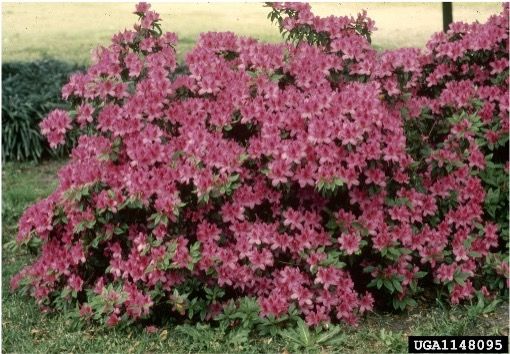
Credit: USDA APHIS PPQ—Oxford, North Carolina, USDA APHIS PPQ, Bugwood.org
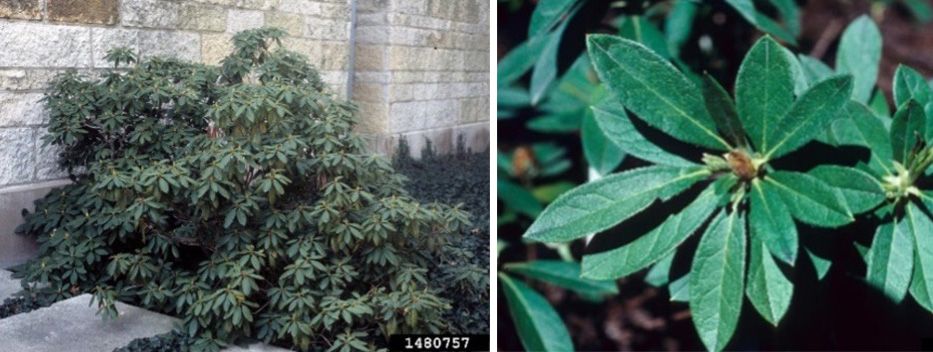
Credit: Left: Richard Webb, Bugwood.org; Right: John Ruter, University of Georgia, Bugwood.org
Black Locust, Robinia pseudoacacia
Description
Black locust is most commonly found in the Florida Panhandle and is also known as false acacia and locust. As a plant, black locust prefers rich, moist soil and is most often found along waterways. It is often utilized as an ornamental in landscaping because it tolerates dry climates well. Trees typically reach a height of 40–100 feet with a diameter of 2–4 feet. Leaves are alternate and compound (odd-pinnate), dark-green on top, and lighter colored on the bottom. Leaves are attached to the branch with slender, hairy petioles that are grooved and swollen at the base. Young trees and new growth tend to have spines. Flowers are cream-white and arranged in loose, drooping 4- to 8-inch-long clumps; male and female flowers are on separate plants. Fruit is pealike and 2–4 inches long and 0.5 inch wide, containing 4–8 seeds.
Toxicity
The primary toxic components of black locusts are lectins, more specifically, toxalbumins called robin and robinin, which are large proteins that are very similar in makeup to ricin found in castor bean and abrin found in rosary pea. Toxalbumins disrupt the protein synthesis of cells, leading to cell death and eventual organ failure. Horses are highly sensitive to this toxin, and will present with symptoms within one to two hours of ingestion. The highest concentration of these toxins is found in the inner bark of a grown plant, seeds, and leaves, as well as new growth.
Symptoms
Poisoning from black locust often presents as colic, constipation followed by diarrhea, rapid respiration, dilated pupils, muscle weakness, and posterior ataxia (incoordination of the hind limbs). In severe cases, a horse may even develop laminitis.
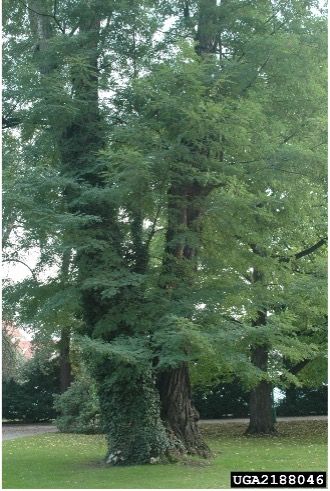
Credit: Chris Evans, University of Illinois, Bugwood.org
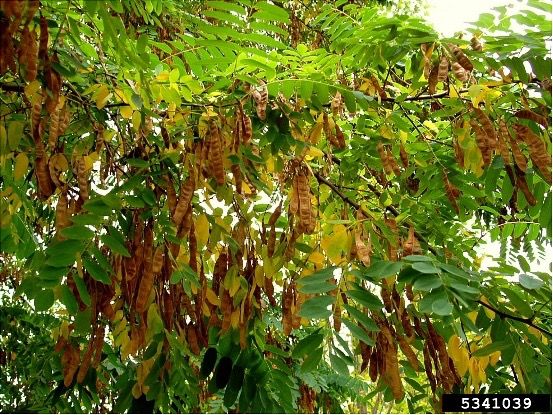
Credit: Jan Samanek, Phytosanitary Administration, Bugwood.org
Black Walnut, Juglans nigra
Description
Black walnuts are found throughout the entire state of Florida. They are often used as windbreaks and shade trees in pastures and along fence lines. Black walnuts grow into large trees with a rough, brown bark. Trees reach a height of 50–75 feet, but they are capable of growing to 150 feet. Leaves are up to 2 feet long with 5–11 pairs of leaflets along a central axis and a single leaflet at the tip (odd-pinnate). The midrib of the lateral leaflets is off-center with the wider part of the leaflet toward the leaf tip. Flowers are not showy, and grow in elongate green clusters. The fruit is 1.5–2.25 inches in diameter, consisting of a hard-shelled, furrow nut enclosed in a green to black husk.
Toxicity
While the exact toxin of black walnut is not known, black walnuts are known for causing laminitis and lameness in horses. This poisoning most often occurs when fresh black walnut shavings are used as a bedding source. Even though well-aged shavings are generally considered safe, shavings used as bedding materials with a composition of as little as 20% black walnut shavings retain the potential to cause laminitis.
Symptoms
Black walnut poisoning causes an inflammatory condition of the hoof called laminitis. Clinical signs may include edema (swelling) of the lower legs, difficulty standing, reluctance to move, lameness, and colic in some cases. The diagnosis is made by confirming clinical signs of laminitis and identifying black walnut shavings in the horse's bedding.

Credit: Chris Evans, University of Illinois, Bugwood.org
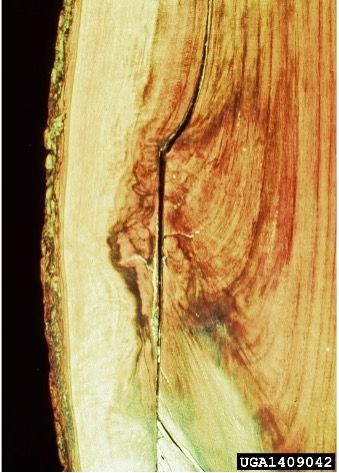
Credit: USDA Forest Service—Northeastern Area, USDA Forest Service, Bugwood.org
Boxelder, Acer negundo
Description
Boxelder is often planted as a shade tree, and it prefers flood plains, riverbanks, and wet lowlands; it is also considered a weedy tree in many parts of the United States. Boxelder is a part of the maple family and is also known as ashy leaf maple, fresno de guajuco, three-leaf maple, and even poison-ivy tree. Trees are fast-growing and typically reach heights of 35–80 feet tall with a trunk diameter of 12–20 inches. Multi-trunked trees are common and can form impenetrable thickets. Shoots are green and often have a whitish to pink waxy coating when young. Branches are smooth and brittle, and tend to retain a fresh green color rather than bark. Leaves are pinnately compound with 3–7 leaflets that are 2–4 inches long and 1.25–2.75 inches wide with slightly serrated margins. Fruits are paired samaras on drooping racemes; seeds are prolific and fertile.
Toxicity
Boxelder seeds contain the toxin hypoglycin A, which causes a serious muscle condition called equine atypical myopathy or seasonal pasture myopathy. Affected horses suffer widespread injury to muscle tissues throughout the body. Both skeletal and cardiac muscle tissues are affected. This condition occurs as a result of hypoglycin A interfering with normal muscle energy metabolism. Boxelder poisoning can occur quickly after consumption of toxic leaves or seeds, and the case fatality rate is very high once horses show clinical signs of illness. Risk factors for boxelder poisoning include horses in pastures with boxelder trees, inadequate available grass pasture or hay, and recent wind or rainfall leading to seeds and leaves falling to the ground.
Symptoms
Horses who are suffering from boxelder poisoning present with stiffness, difficulty walking, sweating, dark red to brown urine, and labored respiration. Some horses may also show signs of colic.
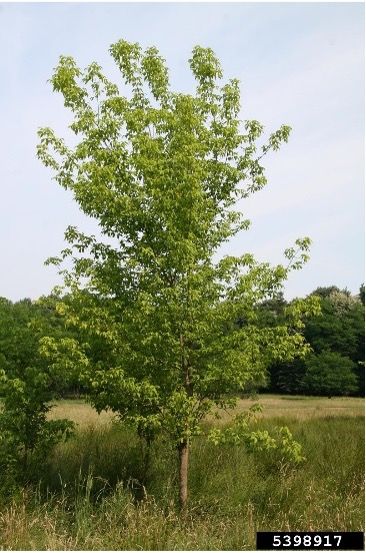
Credit: Robert Vidéki, Doronicum Kft., Bugwood.org
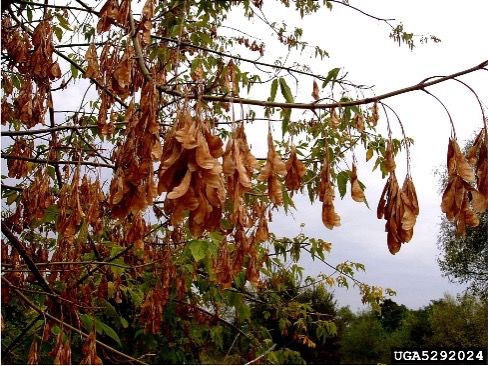
Credit: Jan Samanek, Phytosanitary Administration, Bugwood.org

Credit: Bill Cook, Michigan State University, Bugwood.org
Bracken Fern, Pteridium aquilinum
Description
Bracken fern is a perennial found throughout Florida. It grows in an upright manner with branching fronds and can reach up to 5 feet tall. The leaves (fronds) are triangular and have reproductive spores on the underside of the leaf. The blades (leaves) of the fronds grow nearly horizontal. The blades are divided into leaflets (pinnae), giving the impression of a 3-part leaf. The pinnae are further divided into pinnules (subleaflets), which are oblong with smooth margins.
Toxicity
In horses, bracken fern poisoning most commonly results in a thiamine (Vitamin B1) deficiency as a result of thiaminase, an enzyme that inhibits the absorption of thiamine. While all parts of bracken fern contain thiaminase, it is concentrated in the roots and new growth. For poisoning to occur, large amounts (potentially hundreds of pounds) of bracken fern must be consumed repeatedly over multiple months. While most poisonings occur due to the lack of alternative food sources, it has been noted that some horses develop a preference and may choose to consume this plant even if other sources of food are readily available.
Symptoms
Horses suffering from a thiamine deficiency as a result of bracken fern toxicity may present with depression, weakness, and blindness. Rarely, horses can die of bracken fern toxicity.

Credit: Chris Evans, University of Illinois, Bugwood.org
Cherry, Prunus spp.
Description
For the purposes of this review, the classification “Cherry” includes chokecherry, pin cherry, and black cherry, among other species not commonly found in Florida. While each cherry species is slightly different, all share the same toxic principles for horses. Trees typically reach a height of 50 feet. They tend to have alternate, simple oval leaves with serrated margins and approximately eight pairs of veins, 2–6 inches long. Flowers are typically white and appear in clusters of 3 to 5. The fruit is berrylike, shiny, and black to red in color.
Toxicity
The genus Prunus contains cyanogenic glycosides amygdalin, prunasin, and prulaurasin. Amygdalin is found in the seeds and pits, while prunasin and prulaurasin are found in all the other parts of the plants. In mature plants, these cyanogenic glycosides remain at a level in which poisoning is unlikely, although new growth and weather that stresses the plant, such as a frost or drought, cause an increase in the presence of cyanogenic glycosides, which in turn increases the likelihood of poisoning. These cyanogenic glycosides are housed in a protective membrane within the plants. These protective membranes can be broken down through chewing or wilting of the plant or from stress, such as drought. Horses are less likely to experience poisoning because their stomachs are acidic and largely able to deactivate the harmful enzymes contained by cyanogenic glycosides. If the enzymes are not deactivated, they undergo a chemical reaction that results in hydrogen cyanide, which is quickly absorbed and enters the bloodstream. Cyanide inhibits the release of oxygen from hemoglobin, which results in oxygen deprivation of the tissues.
Symptoms
Poisoning as a result of cyanogenic glycosides occurs quickly, most often within a few hours after ingestion. Horses suffering from this poisoning most often present with rapid, labored breathing, bright-red or muddy-colored mucous membranes, and bright-red venous blood. Many horses will progress to staggering, recumbency, and death if left untreated. Some horses are simply found dead in the pasture.
Additional Notes
The primary concern of poisoning as a result of these plants is with the consumption of new growth. For horses, the genus Prunus requires the consumption of new leaf growth of only 0.25% of the horse's body weight (2.5 pounds for a 1,000-pound horse) to cause poisoning. In contrast, for mature plants, horses would have to consume quantities upwards of 10 pounds to result in clinical illness.
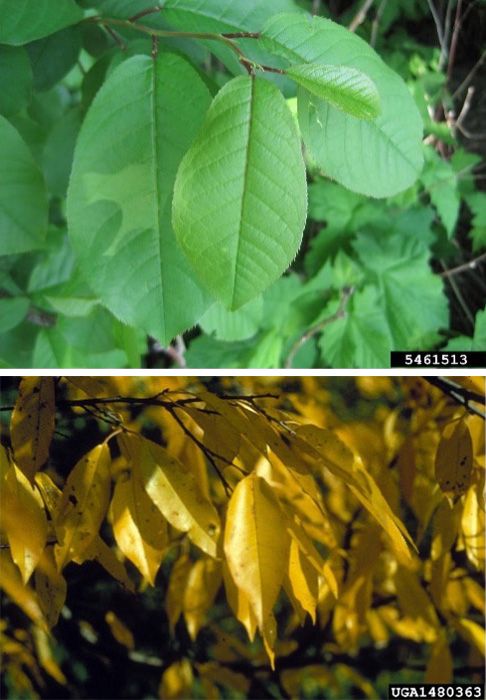
Credit: Top: Rob Routledge, Sault College, Bugwood.org; Bottom: Richard Webb, Bugwood.org
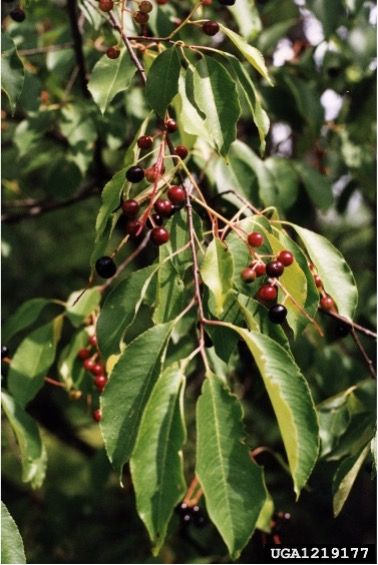
Credit: Bill Cook, Michigan State University, Bugwood.org
Creeping Indigo, Indigofera spicata
Description
Creeping indigo is a prostrate (low-lying) plant with alternate, compound leaves with 5–7 leaflets. Stems can grow up to 6 feet long and root at the nodes. Flowers arise from the base of the leaves and contain numerous pink blooms. Seed pods are bean-like, stiff, approximately 1 inch long, and borne in dense, downward-pointing clusters, and contain 4–8 seeds. Leaflets, stems, and seed pods contain numerous appressed hairs. Taproots are capable of growing at least 2 feet deep.
Toxicity
Creeping indigo contains two primary toxins of concern, 3-nitropropionate (3-NPA) and indospicine. Highly toxic, 3-NPA blocks a key enzyme needed for the mitochondria to turn glucose and oxygen into cellular energy. Toxicity results in cellular energy depletion and horses develop neurological symptoms. Indospicine inhibits nitric oxide synthase, and toxicity results in ulcers on the oral mucous membranes and cloudiness (corneal edema) of the eye.
Symptoms
Poisoning from creeping indigo presents with symptoms such as weight loss, a lack of appetite, increased and labored breathing, high heart rate, excessive salivation, dehydration, pale mucous membranes, and ulcers of the tongue and gums. Additionally, horses will present with neurological symptoms such as ataxia (incoordination), low head carriage, lethargy, paralyzed muzzle and lips, compulsive pacing, head tilting, or head pressing. As symptoms progress, most horses develop an abnormal gait, severe incoordination, and buckling of joints. Eventually, they become incapacitated and unable to rise off the ground.
Additional Notes
Some horses develop a taste for creeping indigo and will seek it out in pastures. The volume needed to cause clinical illness in adult horses is approximately 10 pounds. Foals may also be poisoned through the ingestion of milk through which toxins are passed.

Credit: B. Sellers, UF/IFAS
Crotalaria, Crotalaria spectabilis
Description
Crotalaria is also known as showy crotalaria, Crotalaria montana, brevis rattlebox, showy rattlebox, and rattlepod. Plants are 1–6 feet in height with ridged, smooth stems. Unlike most leguminous species, leaves are simple/unifoliate. The leaf arrangement is alternate. Leaves tend to be widest at the tip and are generally smooth above and hairy beneath. The leaf apex typically ends in a tiny, sharp tip. Flowers are in long, terminal spikes, and are bright yellow with dark lines on the upper petals. Seed pods are 1.25–2 inches long and contain up to 22 seeds per pod.
Toxicity
All parts of the crotalaria plant, including the seeds, are toxic, even when dried. Crotalaria can be inadvertently baled into hay, causing toxicity outside of the plant’s native range if bales are shipped across the country. Seeds may also contaminate grain mixes. Crotalaria contains pyrrolizidine alkaloids, which primarily affect the liver of horses. Pyrrolizidine alkaloids inhibit cell division, leading to liver damage and fibrosis over time. The toxic effects of pyrrolizidine alkaloids are cumulative, meaning that small amounts of plant can be ingested over long periods and cause slowly progressing liver disease.
Symptoms
Symptoms most often include weight loss, lethargy, jaundice (yellow mucous membranes), constipation or diarrhea, red urine, leg edema, and progressive weakness. As liver failure progresses and ammonia accumulates in the blood, horses may also develop neurologic signs of wandering, head pressing, and eventually death.
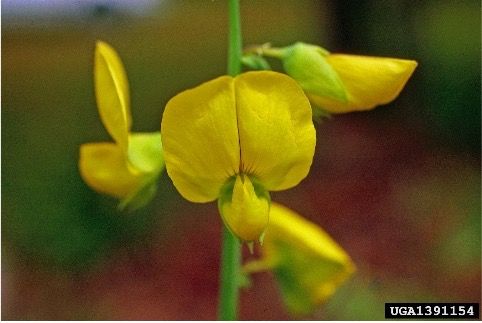
Credit: John D. Byrd, Mississippi State University, Bugwood.org

Credit: John D. Byrd, Mississippi State University, Bugwood.org
Johnsongrass and Sudangrass, Sorghum spp.
Description
Johnsongrass is a non-native grass, and sudangrasses are typically cultivars of Sorghum species. Both grasses are coarse stemmed and drought tolerant, and they grow well in waste areas such as ditches as well as other areas in Florida. Typically, both grasses are stout and hairless, and leaves have a stout center midrib resembling that of corn. Johnsongrass is a perennial plant with both fibrous and rhizomatous roots. Sudangrasses are annuals and only have fibrous roots. The seed head of johnsongrass is an open panicle with sparse dark or black seeds. Seed heads of sudangrasses are quite variable, but seeds tend to be larger than those of johnsongrass.
Toxicity
Johnsongrass and sudangrass contain cyanogenic glycosides in both the stem and leaves. Similar to cherry toxicity, which also results from cyanogenic glycosides, poisoning is not common due to the horse's acidic stomach, which in large part is able to reduce the risk of cyanide poisoning. However, when horses chew the grass, or the grass is trampled or wilted, the protective barrier that encapsulates the cyanogenic glycosides is broken down. If sufficient quantities are consumed, they can overwhelm the stomach's ability to mitigate toxin levels. The toxin, hydrogen cyanide, is then absorbed into the bloodstream, where the cyanide inhibits the release of oxygen from hemoglobin, leading to oxygen deprivation of the tissues.
Symptoms
Initial symptoms of johnsongrass and sudangrass poisoning are labored and open-mouthed breathing, and may also include gasping, frequent urination and defecation, and convulsions. Symptoms will eventually progress to include bright-red venous blood (brown-colored blood may occur with sudangrass poisoning), staggering, neurologic signs, and death.
Additional Notes
The above information specifically pertains to johnsongrass and sudangrass. Some species of Sorghum, such as milo, are commonly used as livestock feed components. While some species of sudangrass with few to none of these cyanogenic glycosides have been developed, the grass contains nitrates; consumption of sufficient quantities can lead to nitrate poisoning. Both johnsongrass and sudangrass are susceptible to nitrate accumulation if over-fertilized. While johnsongrass is sometimes found in south Florida, it is more common north of Interstate 4.
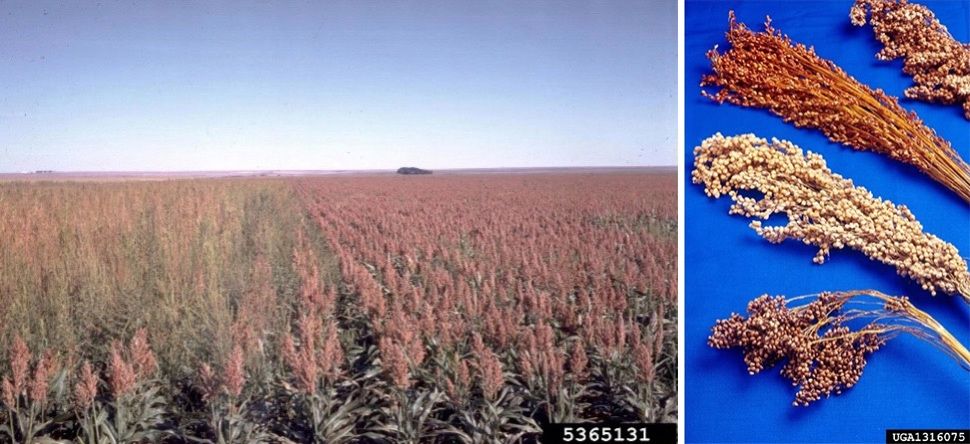
Credit: Left: J. G. Davis, Bugwood.org; Right: Peggy Greb, USDA Agricultural Research Service, Bugwood.org
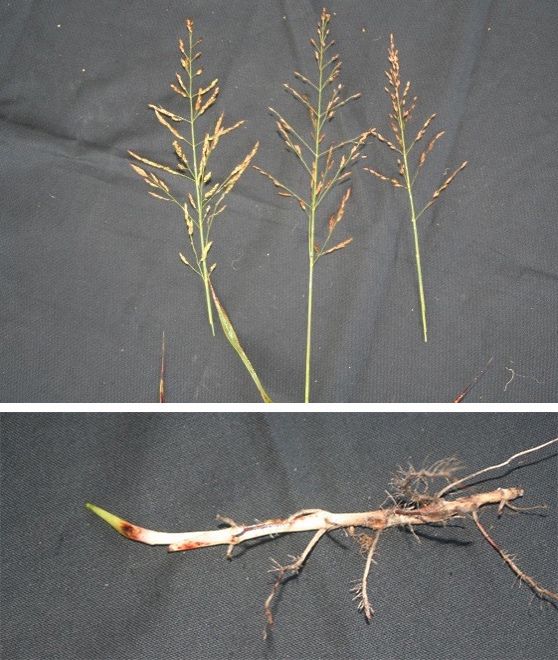
Credit: B. Sellers, UF/IFAS
Nightshade Family, Solanaceae spp.
Description
This collective name envelops a large group of plants, all of which share similar toxic principles in horses, including American black nightshade, horsenettle, tropical soda apple, and many others. This plant is part of a large plant family commonly referred to as nightshades. Black nightshade is also known as nightshade, American black nightshade, and deadly nightshade, among many other common names. In general, this family contains plants that may or may not have prickles or spines; they may be hairy or hairless, and aromatic or non-aromatic. Flowers tend to be yellow, white, blue, or purple, and fruits are berries. Leaves are typically simple but can be 1- to 2-pinnate compound, alternate, or paired, with one leaf smaller. Inflorescences are typically solitary flowers or in small groups.
Toxicity
The toxicity of this plant varies with maturity, environment, and the component of the plant that is ingested. The most toxic part of nightshades is the berries, followed by the leaves and stems. Nightshades pose a number of concerns, the primary of which is the presence of solanine. Solanine is an alkaloid that affects the nervous system by inhibiting the enzyme acetylcholinesterase, an important neurotransmitter. Nightshades also have the potential to accumulate nitrates and may do so at toxic levels for horses.
Symptoms
Horses suffering from nightshade toxicity present with excessive salivation, colic, diarrhea, labored breathing, and muscle tremors. As poisoning progresses, horses experience slow heart rate, incoordination, dilated pupils, weakness, shock, and death.
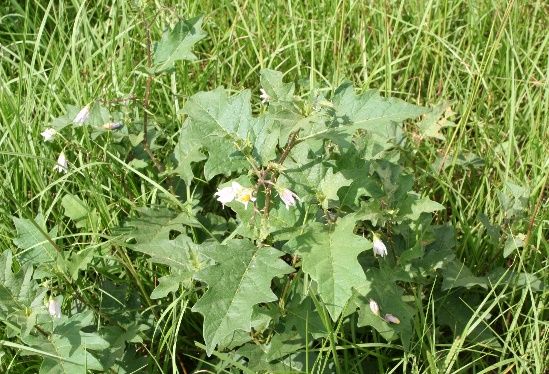
Credit: Brent Sellers, UF/IFAS
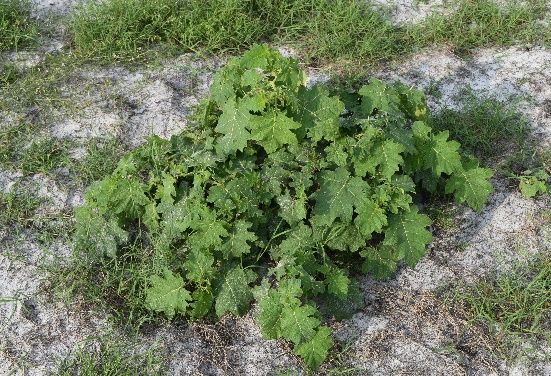
Credit: Brent Sellers, UF/IFAS
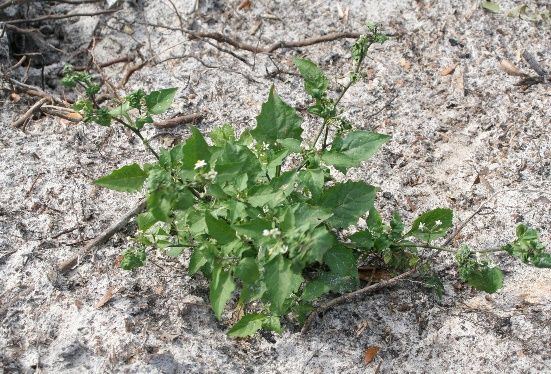
Credit: Brent Sellers, UF/IFAS
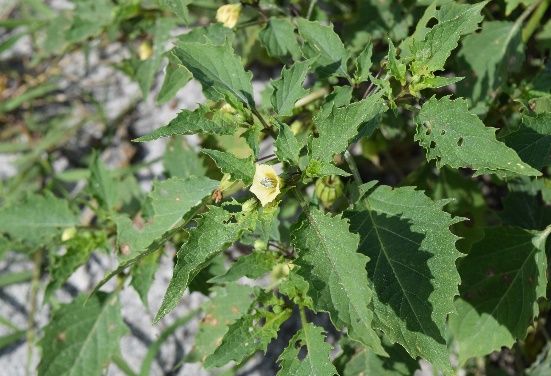
Credit: Brent Sellers, UF/IFAS
Oleander, Nerium oleander
Description
Oleander is a perennial evergreen shrub or small tree ranging from 6 to 18 feet tall with spreading to erect branches. Leaves are simple and occur in whorls of 3 or 4, or rarely opposite on short petioles; they are oblong, glossy dark green above, and pale green below with prominent midrib and secondary veins. Flowers are white, pink or purple, or yellow, and quite fragrant. They occur terminally on branches.
Toxicity
All parts of the oleander plant contain two extremely potent cardiac glycosides: oleandrin and neriine. Oleander poisoning often occurs when horses are allowed to graze near oleander landscaping or when pruned plant components are consumed. These glycosides inhibit the cellular membranes’ ability to regulate sodium, potassium, and calcium, impairing cardiac muscle electrical conductivity and heart function. For horses, a fatal dose of oleander is approximately 0.005% of the horse's body weight (0.8 ounces for a 1,000-pound horse).
Symptoms
Horses suffering from oleander poisoning often present with colic, cardiac arrhythmias, rapid and weak pulse, weakness, dilated pupils, and impaired vision. As poisoning symptoms progress, extreme difficulty breathing, collapse, and death are likely. Treatments often include attempts to prevent toxin absorption. Cardiac arrhythmias may be corrected with anti-arrhythmic drugs and continued supportive therapies, most of which must be administered early in the poisoning process to be effective. In some cases, the only symptom may be sudden death.

Credit: Left: John Ruter, University of Georgia, Bugwood.org; Right: Michasia Dowdy, University of Georgia, Bugwood.org
Red Maple, Acer rubrum
Description
Red maple trees have gained popularity as landscaping trees because they offer beautiful colors and are wet tolerant. Red maple is a medium-sized tree with smooth, gray bark. Branches are typically without hair and red when young. Leaves are simple and palmately 3- to 6-lobed. Upper leaf surfaces are dark green to red, and the lower leaf surfaces are pale. Leaf margins are coarsely serrated; petioles are red. Flowers typically appear before leaves in a bright-red, clustered formation. Fruits are schizocarps of 2 samaras.
Toxicity
Dried and wilted leaves of red maples contain a toxin with oxidant properties, but the exact toxin is not yet known. The toxin oxidizes hemoglobin, a component of red blood cells, which results in damaged hemoglobin referred to as Heinz-Ehlrich bodies. This damage results in methemoglobinemia, which is a condition where hemoglobin is not able to effectively release oxygen for use by tissues. Widespread red blood cell damage leads to hemolytic anemia and impaired ability to carry oxygen in the bloodstream. As little as one pound of wilted red maple leaves may lead to red maple poisoning in horses.
Symptoms
Horses suffering from red maple poisoning present with depression, rapid breathing rate, bluish-colored mucous membranes, and dark-red to brown-tinted urine. The prognosis for horses suffering from red maple poisoning is poor if left untreated.
Additional Notes
Red maple trees should not be planted in or anywhere near locations where horses are kept. Wind may blow leaves over great distances, so it is recommended to carefully consider where red maples are planted.

Credit: John Ruter, University of Georgia, Bugwood.org

Credit: John Ruter, University of Georgia, Bugwood.org
Water Hemlock, Cicuta maculata
Description
Water hemlock is found in marshy areas and along streams or soils near abundant water. It is an erect perennial plant that grows from thick tuberous bases. Stems are stout, smooth, hollow, and sometimes purple-streaked. The primary rootstocks and lower portion of the stems are chambered; the chamber contains an oily substance. Leaves are 1-, 2-, or 3-pinnately compound. White flowers are arranged in large compound umbels.
Toxicity
All parts of water hemlock contain the toxins cicutoxin and cicutol, although toxin levels are found at higher levels in the roots and new growth. These toxins affect the central nervous system, acting as a GABA receptor antagonist. GABA is a neurotransmitter in the brain and spinal cord, and its inhibition results in muscle tremors and violent convulsions.
Symptoms
Horses with water hemlock toxicity present with excessive salivation, dilated pupils, and teeth grinding, and rapidly progress to muscle tremors and violent convulsive seizures. Damage to skeletal and cardiac muscle leads to respiratory paralysis and death. Death typically occurs two to three hours after clinical signs are noted.
Additional Notes
Water hemlock should be dug and burned when possible to prevent remnants of the plant, such as the root, from being left behind. While chemical controls may be effective, dead plant residue can remain toxic and pose a risk to horses and other animals.

Credit: Left: Karan A. Rawlins, University of Georgia, Bugwood.org; Right: John D. Byrd, Mississippi State University, Bugwood.org
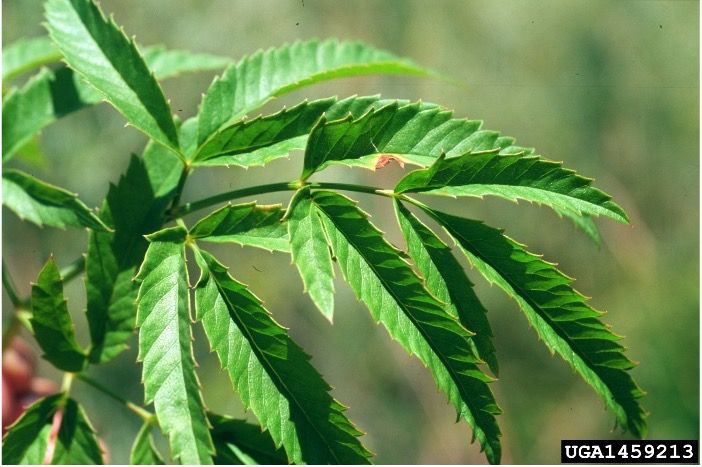
Credit: Steve Dewey, Utah State University, Bugwood.org
Yew, Taxus ssp.
Description
English and Japanese yew species are commonly found in the United States and are often used for hedging landscapes. In general, yews are considered shrubs or small trees with well-developed lateral branches on stems. Stems may have bark that is scaly or fissured. Leaves are needle-like, persistent for several years, simple, alternate, and spirally arranged but often twisted, and they appear 2-ranked. Seeds are produced in cones.
Toxicity
All parts of the plant except for the seed covering, even when dried, are poisonous. Yew contains alkaloids, most notably taxine, which are highly toxic and often found at the highest concentration in the leaves during winter. Taxines interfere with calcium and sodium channels, particularly in the cardiac muscle, resulting in impaired cardiac function and failure. Respiratory failure can also occur.
Symptoms
Yew is extremely toxic to horses, and there is no known treatment. Horses need only ingest as little as eight ounces or a single mouthful to experience poisoning. Horses suffering from yew poisoning present with difficulty breathing, muscle tremors, incoordination, convulsions, and sudden death. Finding the animal dead in the pasture is common, and yew leaves may be recovered from the stomach contents at autopsy.
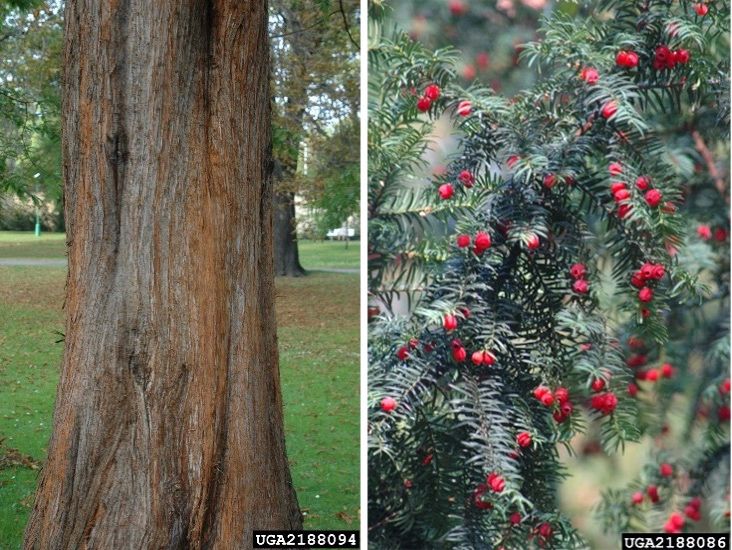
Credit: Chris Evans, University of Illinois, Bugwood.org

Credit: Richard Webb, Bugwood.org
Conclusion
This publication reviews the most common toxic plants likely to be encountered by horses in Florida. Additional plants with the potential to cause illness if consumed in large quantities include bitter sneezeweed, pokeweed, perilla mint, elderberry, milkweed, lantana, oak trees, and jimsonweed. These plants are typically avoided by horses, or large quantities are required to cause toxicity.
A poster titled “Toxic Plants of Florida Pastures” is available to view at the following link and provides visual aids for reference: https://rcrec-ona.ifas.ufl.edu/media/rcrec-onaifasufledu/pdf/2022_FL_toxic_plants_poster.pdf. Horse owners are encouraged to become familiar with the most common toxic plants in their regions and implement pasture management strategies to reduce weed growth and ensure abundant access to grass and forage. To learn more about concerns specific to your area, contact your local UF/IFAS Extension office.
References
Bamka, W., B. Barbour, C. Williams, and L. Gladney. 2017. “FS938: Poisonous Weeds in Horse Pastures.” Rutgers NJAES. https://njaes.rutgers.edu/fs938/
Barr, A. C., and J. C. Reagor. 2001. “Toxic Plants: What the Horse Practitioner Needs to Know.” Veterinary Clinics: Equine Practice 17(3): 529–546. https://doi.org/10.1016/S0749-0739(17)30050-0
Bhaduri Hauck, S. 2016. “Toxic Plant Profile: Rhododendron and Azalea.”
Bildfell, R. 2013. “Overview of Pyrrolizidine Alkaloidosis—Toxicology.” Merck Veterinary Manual. https://www.merckvetmanual.com/toxicology/pyrrolizidine-alkaloidosis/overview-of-pyrrolizidine-alkaloidosis
Boemer, F., J. Detilleux, C. Cello, H. Amory, C. Marcillaud-Pitel, E. Richard, G. Galen, G. van Loon, L. Lefère, and D.-M. Votion. 2017. “Acylcarnitines profile best predicts survival in horses with atypical myopathy.” PLOS ONE 12(8): e0182761. https://doi.org/10.1371/journal.pone.0182761
Boyd, N. S., S. Steed, C. Marble, and A. MacRae. 2016. Biology and Management of American Black Nightshade (Solanum americanum P. Mill.) in Tomato, Pepper, Cucurbit, and Strawberry. HS1176. Gainesville: University of Florida Institute of Food and Agricultural Sciences. https://edis.ifas.ufl.edu/hs1176
Cebra, C., and D. Sisson. 2014. “Diseases of the Cardiovascular and Hemolymphatic Systems.” Llama and Alpaca Care:393–421. https://doi.org/10.1016/B978-1-4377-2352-6.00036-5
Cope, R. B. 2014. “Overview of Cyanide Poisoning—Toxicology.” Merck Veterinary Manual. https://www.merckvetmanual.com/toxicology/cyanide-poisoning/overview-of-cyanide-poisoning
EQUUS. 2004. “10 Most Poisonous Plants for Horses.” https://equusmagazine.com/horse-care/10-most-poisonous-plants-for-horses-8208
EQUUS. 2020. “10 Most Poisonous Plants for Horses.” EQUUS Magazine. https://equusmagazine.com/horse-care/10-most-poisonous-plants-for-horses-8208
González‐Medina, S., F. Montesso, Y.-M. Chang, C. Hyde, and R. J. Piercy. 2019. “Atypical myopathy-associated hypoglycin A toxin remains in sycamore seedlings despite mowing, herbicidal spraying or storage in hay and silage.” Equine Veterinary Journal 51(5): 701–704. https://doi.org/10.1111/evj.13070
Guthrie, T. 2017. “Bracken Fern Poisoning in Horses.” MSU Extension. https://www.canr.msu.edu/news/bracken_fern_poisoning_in_horses
Hinton, T., and G. A. R. Johnston. 2018. “GABA, the Major Inhibitory Neurotransmitter in the Brain.” In Reference Module in Biomedical Sciences. Elsevier. https://doi.org/10.1016/B978-0-12-801238-3.96594-2
Jansen, S. A., I. Kleerekooper, Z. L. M. Hofman, I. F. P. M. Kappen, A. Stary-Weinzinger, and M. A. G. van der Heyden. 2012. “Grayanotoxin Poisoning: 'Mad Honey Disease' and beyond.” Cardiovasc. Toxicol. 12(3): 208–215. doi: 10.1007/s12012-012-9162-2. PMID: 22528814; PMCID: PMC3404272.
Kates, A., D. E. Davis, J. McCormack, and J. Miller. n.d. Poisonous Plants of the Southern United States. 54.
Knight, T. 2019. “Black Locust.” Guide to Poisonous Plants – College of Veterinary Medicine and Biomedical Sciences – Colorado State University. https://csuvth.colostate.edu/poisonous_plants/Plants/Details/111
Knight, T. 2019. “Black Walnut.” Guide to Poisonous Plants – College of Veterinary Medicine and Biomedical Sciences – Colorado State University. https://csuvth.colostate.edu/poisonous_plants/Plants/Details/69
Knight, T. 2019. “Choke Cherry.” Guide to Poisonous Plants – College of Veterinary Medicine and Biomedical Sciences – Colorado State University. https://csuvth.colostate.edu/poisonous_plants/Plants/Details/29
Knight, T. 2019. “Crotalaria.” Guide to Poisonous Plants – College of Veterinary Medicine and Biomedical Sciences – Colorado State University. https://csuvth.colostate.edu/poisonous_plants/Plants/Details/39
Knight, T. 2019. “Rhododendron.” Guide to Poisonous Plants – College of Veterinary Medicine and Biomedical Sciences – Colorado State University. https://csuvth.colostate.edu/poisonous_plants/Plants/Details/111
Knight, T. 2019a. “Black Nightshade.” Guide to Poisonous Plants – College of Veterinary Medicine and Biomedical Sciences – Colorado State University. https://csuvth.colostate.edu/poisonous_plants/Plants/Details/90
Knight, T. 2019b. “Johnsongrass.” Guide to Poisonous Plants – College of Veterinary Medicine and Biomedical Sciences – Colorado State University. https://csuvth.colostate.edu/poisonous_plants/Plants/Details/30
Knight, T. 2019b. “Maple.” Guide to Poisonous Plants – College of Veterinary Medicine and Biomedical Sciences – Colorado State University. https://csuvth.colostate.edu/poisonous_plants/Plants/Details/87
Knight, T. 2019b. “Oleander.” Guide to Poisonous Plants – College of Veterinary Medicine and Biomedical Sciences – Colorado State University. https://csuvth.colostate.edu/poisonous_plants/Plants/Details/60
Knight, T. 2019b. “Water Hemlock.” Guide to Poisonous Plants – College of Veterinary Medicine and Biomedical Sciences – Colorado State University. https://csuvth.colostate.edu/poisonous_plants/Plants/Details/47
Knight, T. 2019b. “Yew.” Guide to Poisonous Plants – College of Veterinary Medicine and Biomedical Sciences – Colorado State University. https://csuvth.colostate.edu/poisonous_plants/Plants/Details/57
Knight, T. 2019c. “Sudan Grass.” Guide to Poisonous Plants – College of Veterinary Medicine and Biomedical Sciences – Colorado State University. https://csuvth.colostate.edu/poisonous_plants/Plants/Details/63
MacKay, R. n.d. “Creeping Indigo Toxicity.” Accessed January 28, 2021. https://largeanimal.vethospitals.ufl.edu/hospital-services/internal-medicine/creeping-indigo-toxicity/
MacKay, R., E. Jennings, B. Sellers, J. Ferrell, and A. House. 2018. Creeping Indigo, a Poisonous Plant of Concern in Florida Pastures. SS-AGR-395. Gainesville: University of Florida Institute of Food and Agricultural Sciences. https://edis.ifas.ufl.edu/ag399
Martinson, K., L. Hovda, M. Murphy, and P. Weicherding. 2018. “Black Walnut: A Toxic Horse Bedding.” https://extension.umn.edu/horse-pastures-and-facilities/black-walnut-toxic-horse-bedding
McGorum, B. C., and R. A. Anderson. 2002. “Biomarkers of Exposure to Cyanogens in Horses with Grass Sickness.” The Veterinary Record 151(15): 442–445. https://doi.org/10.1136/vr.151.15.442
Medina, S. G., C. Hyde, I. Lovera, and R. J. Piercy. 2018. “Detection of Equine Atypical Myopathy-Associated Hypoglycin A in Plant Material: Optimisation and Validation of a Novel LC-MS Based Method without Derivatisation.” PLOS ONE 13(7): e0199521. https://doi.org/10.1371/journal.pone.0199521
Oakes, J. A., and R. Y. Wang. 2016. “Toxalbumins.” In Critical Care Toxicology, edited by J. Brent, K. Burkhart, P. Dargan, B. Hatten, B. Megarbane, and R. Palmer. 1–11. Springer International Publishing. https://doi.org/10.1007/978-3-319-20790-2_98-2
Pinto, C. R. Fontes. 2001. Effects of Nitric Oxide Synthase Inhibitors on Equine and Bovine Follicular Dynamics and Steroidogenesis. 219.
Pollitt, S., M. P. Hegarty, and M. A. Pass. 1999. “Analysis of the Amino Acid Indospicine in Biological Samples by High Performance Liquid Chromatography.” Natural Toxins 7(6): 233–240. https://doi.org/10.1002/1522-7189(199911/12)7:6<233::AID-NT59>3.0.CO;2-3
Popenoe, J., C. Warwick, J. Bourdon, and D. Norman. 2018. Key Plant, Key Pests: Azalea (Rhododendron spp.). Gainesville: University of Florida Institute of Food and Agricultural Sciences. https://edis.ifas.ufl.edu/ep567
Renier, A. 2018. “Boxelder seeds cause seasonal pasture myopathy in horses.” https://extension.umn.edu/horse-pastures-and-facilities/seasonal-pasture-myopathy
Sander, J., J.-M. V. Cavalleri, M. Terhardt, M. Bochnia, A. Zeyner, A. Zuraw, S. Sander, M. Peter, and N. Janzen. 2016. “Rapid Diagnosis of Hypoglycin a Intoxication in Atypical Myopathy of Horses.” Journal of Veterinary Diagnostic Investigation 28(2): 98–104. https://doi.org/10.1177/1040638715624736
Sellers, B., J. Ferrell, and T. Wilson. 2018. Bracken Fern Control in Pastures. SS-AGR-357. Gainesville: University of Florida Institute of Food and Agricultural Sciences. https://edis.ifas.ufl.edu/ag366
Tiwary, A. K., B. Puschner, H. Kinde, and E. R. Tor. 2005. “Diagnosis of Taxus (Yew) Poisoning in a Horse.” Journal of Veterinary Diagnostic Investigation 17(3): 252–255. https://doi.org/10.1177/104063870501700307
Wiese, A. J., R. J. Brosnan, and L. S. Barter. 2014. “Effects of Acetylcholinesterase Inhibition on Quality of Recovery from Isoflurane-Induced Anesthesia in Horses.” American Journal of Veterinary Research 75(3): 223–230. https://doi.org/10.2460/ajvr.75.3.223
Wright, B., A. Bebbington, and T. Leuty. 2008. “Prunus Poisoning in Horses and Other Livestock.” 4. https://www.equineguelph.ca/pdf/facts/Prunus%20Poisoning%20June%2026_08.pdf
Wright, D. L., and A. Blount. 2017. Agronomic Crop Species and Variety Selection. SS-AGR-156. Gainesville: University of Florida Institute of Food and Agricultural Sciences. https://edis.ifas.ufl.edu/aa113